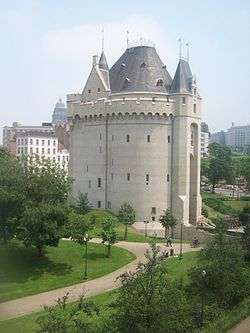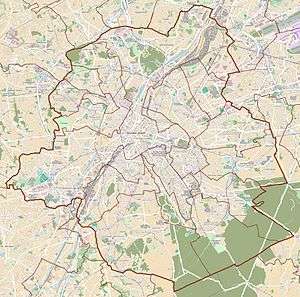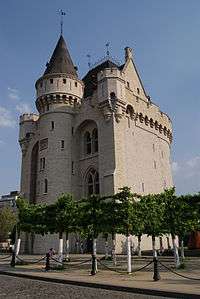Halle Gate
The Halle Gate (French: Porte de Hal, Dutch: Hallepoort) is a medieval fortified city gate and the last vestige of the second walls of Brussels (Belgium).[1] It is now a museum, part of the Royal Museums of Art and History (RMAH). It is located on Boulevard du Midi/Zuidlaan between the City of Brussels and Saint-Gilles municipalities. This site is served by the metro station Porte de Hal/Hallepoort on lines 2 and 6 of the Brussels metro.
| Halle Gate | |
|---|---|
Porte de Hal/Hallepoort | |
| Part of Second City Walls of Brussels | |
| Brussels, Belgium | |
 The Halle Gate in 2008 | |
 Halle Gate | |
| Coordinates | 50.8330°N 4.3449°E |
| Type | City gate |
| Site information | |
| Controlled by | Royal Museums of Art and History |
| Open to the public | Yes |
| Website | Official website |
| Site history | |
| Built | 1381 |
| Materials | Stone |
History
Original structure
Built in 1381, the Halle Gate is a 14th-century city gate from the second set of defensive walls that enclosed Brussels. It first bore the name of Obbrussel Gate (for "Upper Brussels", now Saint-Gilles). The gate was renamed for the city of Halle (French: Hal), now located in Flemish Brabant, which it faces. The original gate included a portcullis and drawbridge over a moat. Though their military function ended in 1564, these features are visible to this day.
While the other six gateways and the defensive walls were demolished between 1818 and 1840 to make way for Brussels' inner ring road, the Halle Gate survived as it then served as a military prison. It was at other times used as a customs house, a granary, and a Lutheran church. In 1840, the street just inside of the gate was raised 3 metres (9.8 ft), making it impassable to vehicles.
- The Halle Gate in 1612, depicted in a drawing by Remigio Cantagallina
 The Halle Gate in 1786
The Halle Gate in 1786 The Halle Gate on the 18th-century Ferraris map
The Halle Gate on the 18th-century Ferraris map
19th-century restoration
%2C_Brussels%2C_Belgium_(ca._1890-1900).jpg)
From 1868 to 1871, as the city was being modernised, architect Henri Beyaert, with little regard for historical accuracy, transformed the austere medieval tower into something of a neo-Gothic castle, which fit better with the contemporary romantic perception of the Middle Ages.[1] The outer entrance, now facing Saint-Gilles, is closer to the original appearance. In front of the inner gate, facing the City of Brussels, Beyaert added a circular tower topped by a large conical roof, containing a monumental spiral staircase. The old, rectangular windows were replaced by ogival ones. Beyaert also added turrets, a walkway and new battlements.
In 1847, the Halle Gate was included in Belgium's Musée royal d'Armures, d'Antiquités et d'Ethnologie ("Royal Museum of Armour, Antiquities and Ethnology"), now named the Royal Museums for Art and History. The collections included diplomatic gifts, mementoes and curiosa owned by the Dukes of Burgundy and subsequently the Habsburg archdukes, and which had been placed, until then, in various locations in Brussels. By 1889, the Halle Gate had become too small to house most of the collections, which were relocated to the Cinquantenaire/Jubelpark Museum. The gate continues to display armour and weapons.[2]
20th century–present
In 1976, the Halle Gate was in a dangerous state of disrepair and was closed. The building received protected status on 13 September 1990.[3] Finally renovations began, and it was reopened in 1991. Further restoration was stalled by lack of money, and the museum only housed temporary exhibitions for several years. In March 2007, a new extensive restoration began. The gate finally reopened on 6 June 2008, with the "Saint-Gilles" (drawbridge) entrance as the prestigious main entrance to the building.
Right next to the Halle Gate is a metro station with the same name with artworks by the famous Brussels artist François Schuiten.
Museum
The museum displays exhibits about the history of the building, as well as of the City of Brussels and its defence. The collection includes the parade armor of Archduke Albert of Austria, Governor General of the Habsburg Netherlands in the 17th century. The main parts of the museum, each on a separate floor, are:
- Armour and Armaments, in a small room off the central passage
- the Gothic Room, above, containing the history of the fortifications of Brussels and of the Halle Gate
- the Guilds Room, showing the role of the trade guilds of the city
- a temporary exhibition space
- a walkway round the battlements, offering a panorama of the city
- the roof space for small exhibitions
 The Halle Gate in 2011, Sint-Gillis (Saint-Gilles)' side |
 The Halle Gate in 2011, City of Brussels' side |
In art
The Halle Gate was represented, around 1565–1568, by Pieter Bruegel the Elder in his painting The Wine of Saint Martin's Day.
References
- Fun, Everything is (2017-03-10). "Halle Gate | Brussels Museums". Brussels Museums. Retrieved 2018-06-14.
- "History | KMKG". www.kmkg-mrah.be. Retrieved 2020-06-27.
- "Bruxelles Pentagone - Porte de Hal - Boulevard du Midi 150 - Porte de Hal". www.irismonument.be. Retrieved 2019-10-27.
Bibliography
- Squilbeck, Jean (1970). "Le centenaire de la restauration de la Porte de Hal". Brabant, revue trimestrielle de la Fédération touristique (in French): 20–27.
External links
| Wikimedia Commons has media related to Porte de Hal/Hallepoort. |